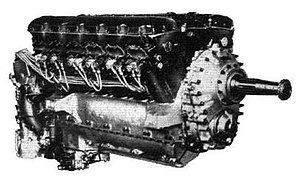 | ||
The Rolls-Royce Goshawk was a development of the Rolls-Royce Kestrel that used evaporative or steam cooling. In line with Rolls-Royce convention of naming piston engines after birds of prey, it was named after the goshawk.
Contents
- Design and development
- Variants
- Applications
- Application list
- Specifications Goshawk I
- General characteristics
- Components
- Performance
- References
The engine first ran in 1933 and provided 660 horsepower (490 kW). Only a few engines were built as the aircraft designs intended to use it were not adopted by the Royal Air Force. The Goshawk was used to power the Short Knuckleduster, the Supermarine Type 224 (a predecessor to the Supermarine Spitfire) and other prototype aircraft.
Design and development
The Goshawk was developed from the Kestrel IV prototype engine, to use evaporative (also known as "steam") cooling. Rather than keep the cooling liquid below its boiling point in the cooling system, the coolant was allowed to boil; the phase change from liquid to vapour takes more heat from the engine, so less coolant is needed. However, instead of a radiator to take the heat from the coolant, a condensor was required to turn the vapour back to liquid. This had to be much larger than a radiator and added drag to the aircraft design.
Twenty engines were built and they flew only in prototypes as a few manufacturer's private ventures and "one offs". Powers for individual installations are quoted between 650 and 700 hp (520 kW). Problems with coolant leaks, coolant pumping and the realisation that large wing mounted radiators would be vulnerable to combat damage caused the project to be cancelled although valuable lessons had been learned and were put to good use with development of the later Merlin.
Variants
Applications
The Goshawk was the power unit specified for the twin engined Short Knuckleduster flying boat (K3574) to Specification R24/31 and "preferred" for submissions to Air Ministry specification F7/30 for a fighter aircraft. Goshawks were used by all three officially sponsored prototypes, the Supermarine Type 224 (K2890),the Westland F.7/30 (K2891) and the Blackburn F3 (K2892), which only taxied with the Goshawk fitted and did not fly, in addition to two private venture entrants, the Bristol Type 123 and the Hawker P.V.3.
The Goshawk also powered Hawker's privately developed "High Speed Fury Mk 2" (K3586) and "Intermediate Fury" 2" (the latter Hawker's own development aircraft and "hack" serial G-ABSE) and the Westland Pterodactyl V (K2770) and was installed for trials in the Gloster TSR.38 (S1705), and the first Gloster Gnatsnapper prototype (N227).
Application list
Specifications (Goshawk I)
Data from Lumsden
